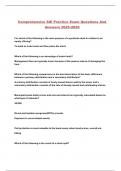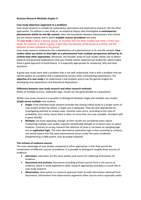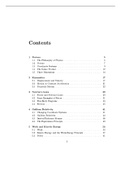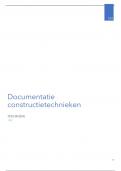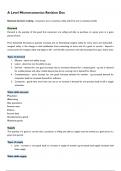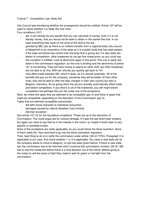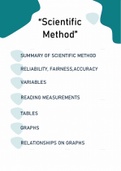Adaptation
o Caused by physiological stresses and potentially injurious conditions
o Result is a new steady state and preserving viability and function
Cell injury
o Caused by exceeded adaptive capability or harmful/excessive external stress
o Results in reversible injury → cell can return to stable baseline
o Results in irreversible injury, when stress is severe, persistent or rapid in
onset
Cell death
o Caused by irreversible injury, ischemia (lack of blood flow), infections, toxins
and immune reactions.
o Also, normal and essential process in embryogenesis and maintenance of
tissue homeostasis
Causes of cell injury
Hypoxia and ischemia
o Hypoxia = oxygen deficiency
Anemia or CO poisoning
Ischemia = reduced blood supply
Arterial obstruction → ischemia → hypoxia
Results in deficiency of essential nutrients and buildup of toxic
metabolites
Toxins
All substances used excessively or inappropriately can be toxic
Air pollutants, insecticides, CO, cigarette smoke, ethanol, glucose, salt,
water and oxygen
Infectious agents
All types of disease-causing pathogens
Viruses, bacteria, fungi and protozoans
Immunologic reactions
Autoimmune reactions against one's own tissues
Allergic reactions against environmental substances
Excessive or chronic immune responses to microbes
Elicit inflammatory reactions, which are often the cause of damage to
cells and tissues
Genetic abnormalities
Can result in pathologic changes
Congenital malformations as in Down Syndrome
Single amino acid substitution in hemoglobin giving rise to sickle cell
anemia
May cause cell injury as a consequence of deficiency of functional
proteins
Enzymes in inborn errors of metabolism, accumulation of damaged
DNA or misfolded proteins → all trigger cell death when beyond repair
Nutritional imbalances
o Protein-calorie insufficiency → cell injury
o Specific vitamin deficiencies
o Excessive dietary intake may result in obesity → type 2 diabetes and
atherosclerosis
Physical agents
o Trauma, extremes of temperature, radiation, electric shock and sudden
changes in atmospheric pressure → wide range of effects
, Aging
o Cellular senescence results in a diminished ability of cells to respond to stress
and eventually, the death of cells and of organism.
Sequence of events in cell injury and cell death
Reversible Cell Injury
Reversible injury is the stage of cell injury at which the deranged function and morphology of
the injured cells can return to normal if the damaging stimulus is removed.
Failure of energy-dependent ion pumps → inability of maintaining ionic and fluid
homeostasis → taking in too much water → swollen cells
Degenerated organelles and lipids may accumulate inside the injured cell
Induce specific alterations in cellular organelles
o Smooth ER is involved in metabolism of various chemicals
o Cells exposed to these chemicals show hypertrophy (increase in volume) of
ER → adaptive response → important functional consequences.
o Cells adapted to one drug demonstrate an increased capacity to metabolize
other compounds handled by the same system.
With persistent or excessive noxious exposure → point of no return → cell
death
o If biochemical and molecular changes that predict cell death can be identified,
the transition from reversible to irreversible can be prevented
No definitive morphological or biochemical correlates of irreversibility,
but characterized by three phenomena
1. Inability to restore mitochondrial function
2. Loss of structure and functions of plasma membrane
and intracellular membranes
3. Loss of DNA and chromatin structural integrity
Morphology
Cellular swelling → increased permeability of plasma membrane. Causes pallor,
increased turgor and increase in organ weight.
Fatty change → appearance of triglyceride containing lipid vacuoles. Involved in lipid
metabolism.
Plasma membrane alterations → blebbing, blunting or distortion of microvilli
Mitochondrial changes → swelling and phospholipid rich amorphous densities
Dilation of ER → detachment of ribosomes and dissociation of polysomes
Nuclear alterations → clumping of chromatin
Cell Death
When cells are injured, they die by different mechanisms, depending on the nature and
severity of the insult.
Severe disturbance (loss of oxygen and nutrients supply or action of toxins) cause a
rapid and uncontrollable form of death called accidental cell death
o Accidental cell death = necrosis
o Commonly encountered injuries, resulting from ischemia, exposure to toxins,
infections and trauma.
o Inevitable end result of severe damage that is beyond salvage and is not
thought to be regulated by specific signals or biochemical mechanisms
o Happens accidentally, because injury is too severe to be repaired
When the injury is less severe, or cells need to be eliminated during normal
processes, they activate a precise set of molecular pathways that culminate in
death.
o These cell deaths can be manipulated by therapeutic agents of genetic
mutations
o Regulated cell death → apoptosis
o Necroptosis → some features of necrosis and apoptosis




